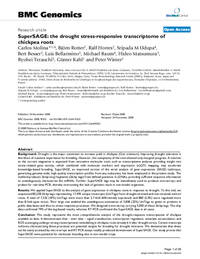SuperSAGE: the drought stress-responsive transcriptome of chickpea roots

Authors:
Background
Drought is the major constraint to increase yield in chickpea (Cicer arietinum). Improving drought tolerance is therefore of outmost importance for breeding. However, the complexity of the trait allowed only marginal progress. A solution to the current stagnation is expected from innovative molecular tools such as transcriptome analyses providing insight into stress-related gene activity, which combined with molecular markers and expression (e)QTL mapping, may accelerate knowledge-based breeding. SuperSAGE, an improved version of the serial analysis of gene expression (SAGE) technique, generating genome-wide, high-quality transcription profiles from any eukaryote, has been employed in the present study. The method produces 26 bp long fragments (26 bp tags) from defined positions in cDNAs, providing sufficient sequence information to unambiguously characterize the mRNAs. Further, SuperSAGE tags may be immediately used to produce microarrays and probes for real-time-PCR, thereby overcoming the lack of genomic tools in non-model organisms.
Results
We applied SuperSAGE to the analysis of gene expression in chickpea roots in response to drought. To this end, we sequenced 80,238 26 bp tags representing 17,493 unique transcripts (UniTags) from drought-stressed and non-stressed control roots. A total of 7,532 (43%) UniTags were more than 2.7-fold differentially expressed, and 880 (5.0%) were regulated more than 8-fold upon stress. Their large size enabled the unambiguous annotation of 3,858 (22%) UniTags to genes or proteins in public data bases and thus to stress-response processes. We designed a microarray carrying 3,000 of these 26 bp tags. The chip data confirmed 79% of the tag-based results, whereas RT-PCR confirmed the SuperSAGE data in all cases.
Conclusion
This study represents the most comprehensive analysis of the drought-response transcriptome of chickpea available to date. It demonstrates that – inter alias – signal transduction, transcription regulation, osmolyte accumulation, and ROS scavenging undergo strong transcriptional remodelling in chickpea roots already 6 h after drought stress. Certain transcript isoforms characterizing these processes are potential targets for breeding for drought tolerance. We demonstrate that these can be easily accessed by micro-arrays and RT-PCR assays readily produced downstream of SuperSAGE. Our study proves that SuperSAGE owns potential for molecular breeding also in non-model crops.
